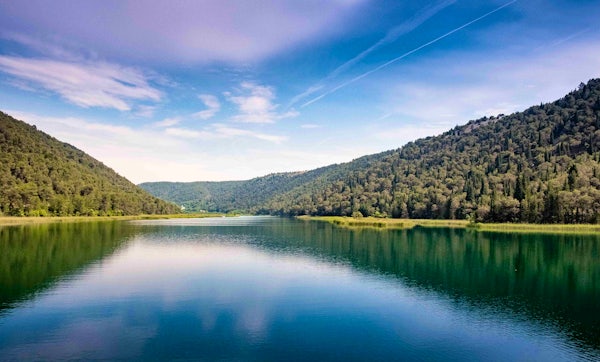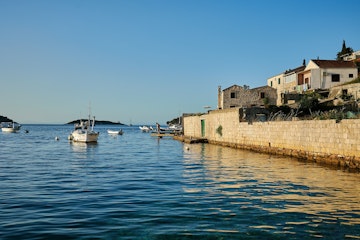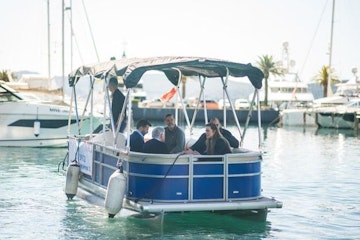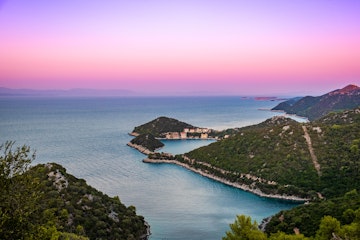Sustainable Tourism Innovations - an Interview with Prince Njegoš Petrović

Fresh from our participation at the prestigious Adria ESG Summit this year, we had the unique opportunity to interview Prince Njegoš Petrović. The conversation highlighted shared commitments to protecting our natural heritage, promoting sustainable maritime practices, and inspiring communities across the region to adopt responsible tourism practices. Prince Njegoš Petrović’s project, EKOBROD, uses compressed air as a promising solution for sustainable maritime travel. By harnessing local resources such as sun, wind, and waste, it eliminates the need for imported materials and reduces energy loss from transportation.
This conversation marks another step in Green Sail’s mission to connect influential voices with innovative ideas for a cleaner, greener future for our seas.
How did the idea for EKOBROD come about, and what inspired you to support its development?
It all began with a meeting in Paris with Croatian architect Mario Matulić, who told me about two innovative and ecological technologies being developed by start-up companies in France.
The first technology is the “Retrofit” application, which enables existing engines (thermal or electric) to be adapted to run on compressed air without combustion and without the need for batteries. The second is a waste-treatment system using laser pyro-gasification in anaerobic conditions. It is efficient and compact, making it possible to create mobile waste-processing stations. Mario was already envisioning ferryboats powered by compressed air and equipped with pyro-gasification containers that could travel to islands and process their waste on site. The energy produced from waste treatment would not only power the ferries but also supply reverse-osmosis plants to provide drinking water for the islands.
In short, it’s a positive exchange of “waste for drinking water.” I was completely fascinated and wanted to introduce these clean technologies in Montenegro, believing they would resonate in a country that declared itself an “ecological state” in its Constitution. Based on these technologies, together with Mario and his partners, we prepared a program called EKOMED, with several pilot projects presented in Montenegro.
Beyond attractive documents, it was necessary to prove that these new technologies actually worked. That’s how the EKOBROD project was born, enabling clean maritime transport with no CO₂ and no batteries. Sadly, in the meantime, our friend Mario passed away.
For the prototype, we chose a type of pontoon with external compressed-air motors, allowing coastal transport of passengers as well as containers with waste and various goods. We even proposed an application for people with disabilities in connection with the Paralympic Games. Only in March, thanks to the support of the Montenegrin Ministry of Maritime Affairs, were we able to build this boat/pontoon and present it at the ESG Adria Summit.
We are now looking for partners to further develop applications of this technology. We believe it could be of particular interest to companies engaged in maritime transport, especially ferries with polluting engines. We also believe Croatia might show interest. I hope that one day such a ferry will sail the Adriatic bearing the name of Mario Matulić.
Beyond my ecological convictions, I am especially driven by the urgent need to protect the natural wealth of the Adriatic coast, on which the economic survival of our countries depends. I also firmly believe that an ecological state is the only solution for the harmonious development of our region.
Can you explain how the EKOBROD design enables navigation in shallow waters, and why this is important?
For the prototype, we selected a basic pontoon model with metal floats and a very shallow draft, which allows navigation in shallow rivers as well as easy docking along shores or pontoons for boarding passengers and loading goods. This basic pontoon offers numerous options for adaptation to different needs. The floats can also contain compressed-air tanks without burdening the deck space. However, the primary function of this prototype, which we named EKOBROD, is above all to promote this new technology applied to decarbonised maritime transport.
Could you describe the compressed-air propulsion technology? What is the working pressure, and how much energy is required per charge?
The explosion in an internal-combustion engine is replaced by the expansion of compressed air at pressures between 5 and 60 bar. The goal is to use as little compressed air as possible, which is why we patented various components that allow precise injection control, injecting only the necessary number of molecules at the most efficient moment. In this way, we developed an engine three times smaller and lighter than an internal-combustion engine of the same power.
We also created a concept that allows the power batteries in a vehicle or boat to be replaced with an air tank feeding a small generator to supply energy to an electric motor. A 3.5-ton cargo vehicle can travel 200 km with 1 m³ of air at 350 bar, while a 6-meter pontoon can operate for 6 to 8 hours.
What is the projected autonomy of EKOBROD on a single compressed-air fill, and how does it compare in range to classic diesel vessels?
As mentioned, the autonomy of the compressed-air system is similar to that of batteries at a pressure of 350 bar. However, it is now possible to use tanks at 700 bar, which would double the autonomy and bring it close to that of diesel engines. In addition, some manufacturers already offer tanks with pressures up to 1,100 bar.

What is the efficiency of the mobile compressed-air filling station? How long does a full refill take, and which technologies are used for energy conversion?
Filling can be done with small diving compressors, which can fill the pontoon in 2 to 8 hours, depending on compressor capacity, or through fast filling from large mother tanks, which takes about 5 minutes.
What about long-term maintenance of compressed-air tanks? What are the safety, inspection, and material-recycling requirements?
In general, maintenance of a compressed-air system is much simpler than for thermal systems, as there is no carbon residue or wear. As for the tanks, visual inspections vary from country to country, but very quick checks can be performed every three years.

Have you run performance simulations for EKOBROD in colder or warmer seasons? How do changes in water and air temperature affect capacity and autonomy?
Unlike batteries, every degree above 25 °C reduces consumption, while lower temperatures are expected to increase consumption, similar to batteries. We are working on solutions for very cold climates.
Is serial production planned? If so, what are the key technical, regulatory, and logistical challenges for expanding the project along the Adriatic coast?
The advantage of this technology is its simplicity and the fact that the required skills are the same as for thermal engines. The design and business model foresee a franchise concept that allows production in many countries, particularly in the former Yugoslav republics, where resources and expertise are still available.

At Green Sail, we are excited about the potential of compressed air as a truly sustainable energy solution. It’s local, clean, and efficient, powered by the sun, wind, and waste, without the need to import materials or lose energy in transport. By using an existing engine with minimal environmental impact and no risk of explosion, compressed air represents a practical, safe, and eco-friendly step toward greener operations.